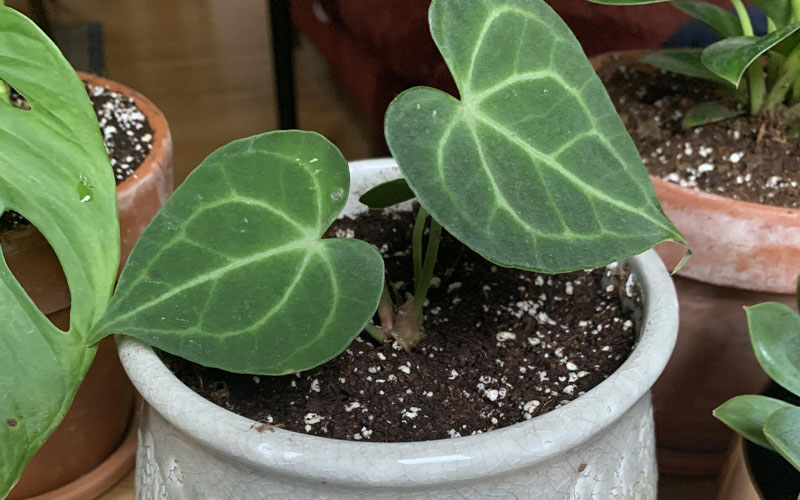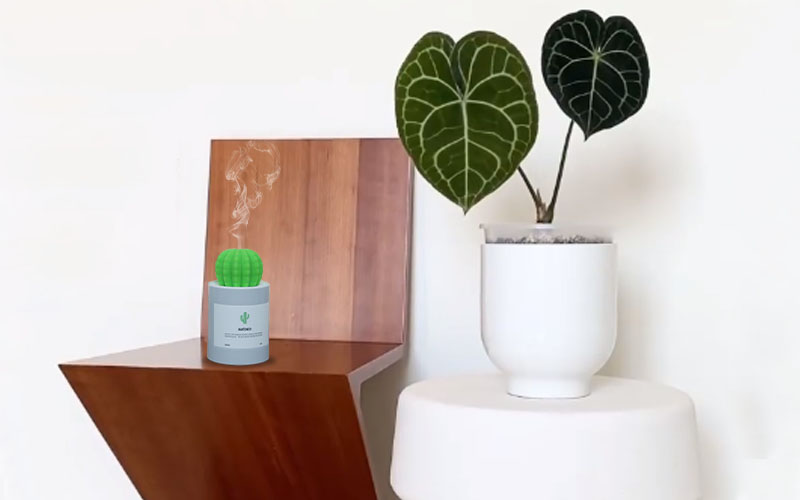The next on our plant-lovers guide is one of the most-popular picturesque anthurium species on Instagram, yes, we are talking about everybody’s favorite, the divine anthurium clarinervium.
It is the next string of hearts plant for gardening enthusiasts.
Native to Chiapas, Mexico, this rare Anthurium has soft velvety heart-shaped dark green leaves with white lines that look like veins.
Before finding out how you can care for this stunning clarinervium plant to grow leathery-thick foliage in no time. First, let’s read why people are so obsessed with this plant:
Anthurium Clarinervium
Anthurium clarinervium is a stunning plant of Mexico with beautiful heart-like leaves that are so velvety and soft to touch.
White long lines extend to the whole foliage, giving it an interesting veiny pattern. The upper part of the anthurium has a dark green hue, while the bottom side is lighter.
You can say its leaves filled with veiny patterns makes Anthurium clarinervium a rare and expensive anthurium.
Here, read easy care steps to plant a healthy clarinervium plant indoors:
How to Care for Anthurium Clarinervium
Bright indirect light, high humidity, a temperature ranging 75°F-85°F, quick-drainage soil filled with ½ diluted fertilizer, and proper watering are ideal conditions for the care of anthurium clarinervium.
Placement & Light

Anthurium clarinervium or velvet cardboard anthurium is a tropical epiphyte and a favorite indoor houseplant.
Their light requirement is similar to monstera epipremnoides; that is, they can’t tolerate direct and harsh light.
If you want to see your Anthurium thrive and survive indoors, you must give it a fair amount of bright indirect light. So, the best placement for these light-lovers can be an east-facing window.
Remember not to give Anthurium, the light that is too bright or direct; otherwise, you might have to deal with scorch, burnt, or brown leaves.
Note: These plants can only grow in medium to bright light, so direct light during winters (short days of sunlight) will not affect the plant foliage.
Temperature
Velvet cardboard anthurium likes to sit in a warm environment similar to the Scindapsus Pictus.
According to a plant expert, the ideal temperature range for anthurium care indoors is 60°F-85°F (16°C-29°C).
For the growing season, 65°F-75°F (18°C-24°C) can be considered ideal, whereas, in winters, you can give it a solid 60°F (16°C). It is advised not to go below that, or else the anthurium plant might freeze.
“If there’s any easiest anthurium plant to grow. I would name Anthurium Clarinervium.”
– An Indoor Houseplant Enthusiast
Soil

Anthurium soil requirements are similar to any other anthurium house plants, which means they don’t like to sit in soggy and over-moisturize soil as they are prone to root rot.
A quick-drainage or aroid potting mix (acidic soil: 5.5pH-6.5pH) is suitable for these anthurium epiphytes.
Do It Yourself: Make your DIY soil for Anthurium by mixing perlite, potting soil, and orchid pot chips (1-part).
Use a mess-free gardening mat to combine all the ingredients and avoid the soil mix from scattering everywhere at your place.
Once you have prepared the anthurium potting soil mix, pour some water over it, and observe how fast the water drains through the pot and soil.
Fertilizer
The ideal anthurium care depends on the light, temperature, and humidity of the spot where they are placed.
Additionally, if the soil, watering, or anthurium fertilizer is not set correctly, the growth of your plant may cease.
So,
To make sure your clarinervium plant is thriving indoors, you need to also keep in check how often you fertilize your velvet cardboard anthurium.
Fertilize it once every month in the growing season (April-October) with any houseplant fertilizer diluted to half-strength.
To grow it all-year-round, adapt a routine of flushing the soil (run water through soil mix for two-three minutes) once every three to four months.
Humidity

Light and humidity are one of the crucial anthurium plant care conditions you need to set out correctly to see your clarinervium thrive all year long.
Yes, anthurium clarinervium loves high humidity around them. Ideal Anthurium Humidity Level: 65%-80%
What will happen if your anthurium clarinervium is not getting enough humidity? The beautiful heart leaves will start to curl, and the edges will become brown crispy.
Of course, you don’t want that to happen, so get a portable humidifier and place it anywhere you want near your plant to provide it with the optimum humid environment.
Or, you can also put a water-pebble tray underneath the pot to help it with the moisture.
And, you will observe it becoming huge in no time with the right care.
Its heart-shaped leaves are enough to beautify your home, but why not take it to the next level? Place gold balls around the pot or attach magical strings to the wall behind the plant to illuminate the stunning Anthurium.
Air-Circulation
Anthurium clarinervium is a rare tropical perennial of Mexico’s landscape. It usually grows on the side of rocks or trees, meaning they are used to having good circulation.
For the anthurium care indoors, you can place the plant under the ordinary ceiling fan (low-speed) to provide it with the necessary air circulation.
Watering

Watering is also a crucial step in anthurium houseplant care.
Now, you might think as they grow on the side of trees or branches, they must require high watering as it rains quite often. Right? Well, it’s not the case here.
Yes, they are drenched usually outdoors, but they also dry out faster due to their exposed root system.
So, how much water Anthurium clarinervium needs when grown indoors? Once or twice every 3-4 days!
Remember to let the top inch dry between the watering sessions as they like to sit in moist soil and not the soggy wet soil.
What if?
You over-watered it, and the beautiful heart-shaped leaf of your Anthurium got sad and turned yellow, expressing its disliking for what you did to them, and now you are thinking, oh I wish I could turn back time to good old days?
Well, don’t worry, not only do they look like blooming hearts, they also behave like ones.
Keep the watering in balance, top 1″ of soil dry but rest moist enough, give good air circulation and high humidity, and your baby Anthurium clarinervium will soon become a big boy anthurium.
Anthurium Clarinervium is a rare tropical plant that can be expensive in some places like Australia or Canada.
Potting & Repotting
The best time to repot the heart-shaped Anthurium is during spring or growing season. But, what are the signs your plant needs repotting?
Any outgrowth (roots coming out of the drainage hole or on topsoil) signals your plant is not getting enough space in the pot to grow.
And, which means it’s time to repot.
Note: Choose one size larger for the pot (than the previous).
The tip is to fill the new pot with a mixture of old soil and fresh potting mix. Gently, place the plant in the center and start adding the soil around it.
Push the plant down into the soil lightly with your fingers. Don’t be harsh on the plant as it is already going through the transfer shock.
Pro-Tip: Dabble water across the plant surface to allow the soil to settle down. It will reduce the plant stress and shock of a new pot.
Here, see a video of repotting Anthurium clarinervium:
Propagation & Growth
How do you grow Anthurium the right way? Is it difficult? No, Anthurium plants are just so easy to grow! Yes! Don’t believe it? Read it down below:
To save the anthurium clarinervium from double stress, it is advised to propagate the plant when you repot it.
You can use the seeds, stem, or root division method for Anthurium propagating.
Seeds:
It is a slow-growing process but worth the effort.
Take out the seeds from the orange berries of anthurium clarinervium and plant them in finer soil.
Root Division:
Carefully separate the roots into sections and plant each root section into a new pot with fresh soil.
Stem Cuttings:
Use a grafter kit to cut the stems (a few inches with 1-2 leaves) and place them into a pot filled with new potting soil mix.
You can also place these stems into a water jar until the roots (2.5cm) reappear.
Or take the stem cutting with roots attached (to support new growth), or else your plant may experience a leaf drop.
Note: Cover the freshly potting plant with a plastic bag and place it in a bright but warm room. (as they need humidity to grow healthy)
If provided the right conditions, anthurium clarinervium can grow up to about 15-25 inches. At the same time, leaves can grow from 5-12 inches.
Here is a video of anthurium clarinervium propagation by stem cuttings and root division:
Pruning
Anthurium clarinervium doesn’t require frequent pruning, but when they do, it is not really tricky.
You can either prune the anthuriums to improve their appearance or growth. Remove any yellow, brown, wilted, or damaged leaves right before the growing season (spring).
Also, check for any spots on the leaves and consider cutting them too (to save the whole plant from getting it). Why? Well, the yellow orangy spots might be tumid mites. You never know!
Note: While pruning, you can make the flower cut or trim any flower stems as they are of no aesthetic value for the anthurium appearance.
Flowering
Yes, the anthurium clarinervium plant does bloom into flowers, but these flower cuts are not like any typical flowers.
Instead, they are unique leafspace-like, also known as flamingo flowers. These blossoms can have different bright color varieties and usually blooms to a size of 3-4 inches.
These velvety flowers shine for a few weeks before fading and dropping.
People often confuse anthurium clarinervium with anthurium crystallinum.
But honestly, if you focus on both plants’ appearance, there would be no anthurium clarinervium vs. crystallinum.
Here’s why:
The leaves of crystallinum are delicate as compared to thick heart-shaped leaves of clarinervium. Moreover, the leaves of anthurium crystallinum are white-violet-berry colored with clean-cut markings.
FAQs
1. Is Anthurium Clarinervium a Poisonous Plant? Or
2. Is Anthurium toxic for cats, dogs, or other pets?
Yes! Yes! And for the last time, Yes!
Anthurium Clarinervium is generally a toxic plant. It can cause ulcers, swelling, oral and chest irritation if ingested mistakenly.
So, altogether, be careful while handling the anthurium and keep your pets out of your plants!
3. Are Anthurium Plants Prone to Pests?
As these plants need high humidity to prosper, you can say pesky bugs like aphids, mealybugs, scales, tumid, or spider mites are more likely to infect the plant.
But, don’t worry.
According to a plant expert, spray surgical alcohol, or use non-rubbing alcohol to clean the leaves and remove the insects.
Final Thoughts
Do you still think why Anthurium clarinervium is so hyped among plant-lovers?
When you buy it, you’ll get why every plant enthusiast is so obsessed with this plant.
Its green velvety heart leaves, white vein stripes, beautiful thick foliage, easy growth, and caring requirements make it an ideal houseplant like Sansevieria.
Lastly,
If you really want to invest in your home decoration or want to give your surrounding an overall green, earthy, flowery, and peaceful ambiance.
In that case, we suggest you should buy this lovely Anthurium clarinervium.

